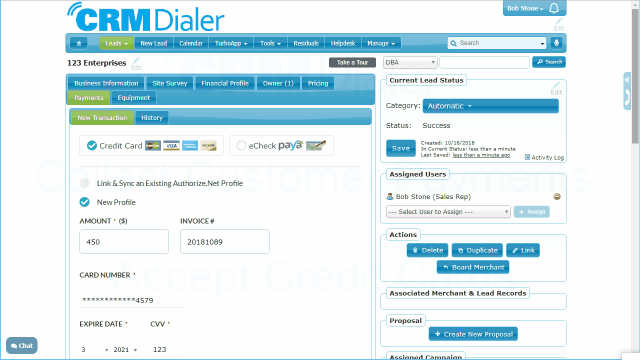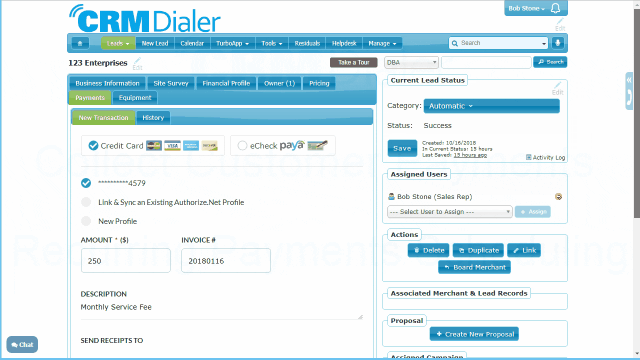
We live in a digital world. The internet is ubiquitous, and there are now entire generations of people who have never known life without it. Online commerce – an area that was once the realm of the earliest adopters – is now the standard. A 2016 Pew Research study found that 79% of Americans shopped online. In Q4 2016, they spent a combined 109.3 billion dollars. A 2016 study also found that 56% of all bills are now paid over the internet.
Simply put, consumers now expect to be able to pay online. A customer that wants to pay online and can’t very well be a customer lost, and offering online payments is a core aspect of offering consumers the quality and scope of service that they demand. A well-designed, easy-to-use online payment solution is something companies simply can’t afford to do without.
And it isn’t only the consumer that benefits. Offering online payments means that businesses get paid faster. Good cash flow management is at the heart of all successful businesses, and expenses don’t take vacations. The longer a company has to wait to have access to the money they’ve earned for their products or services, the bigger the strain on their cash flow. Taking payments online means that companies can get those payments processed incredibly quickly – sometimes even instantly. That’s a financial benefit that simply can’t be ignored.
So just how does a company go about setting up online payments?

The Most Common Ways to Collect Payments Online
As the demand for online payments exploded, so too have the number of processing options that businesses have. Today, companies have more choice than ever in how they take payments from their customers, and the menu can be a bit overwhelming, especially for business owners without previous experience in setting up payment processing. Here are a few of the most popular ways to accept online payments in 2019, along with the benefits and drawbacks provided by each.
PayPal and Third-Party Processors
One of the earliest players in the online payments game is still one of the top dogs. PayPal, founded in 1998, is an online payment processing system that supports online money transfers using its online wallet, credit card payments, and e-checks. PayPal established itself by becoming the go-to payment processor for eBay, who acquired the company in 2002 before spinning it off in 2015. It’s now grown well beyond eBay. Today, PayPal is used web-wide for payments of all types and has over 254 million active users around the globe.
PayPal is an attractive option for many companies for a number of reasons. The first is its user base. With 254 million consumers already signed up, it’s a familiar and highly trusted payment gateway that consumers are confident in using. Another major upside is that PayPal can process credit card payments even for users that aren’t registered. That essentially means a business with a PayPal account can accept payments online from anyone with a Visa, Mastercard, American Express, or Discover Card.
The downside of PayPal is the fees. An average merchant account has fees in the range of 1.8% plus $0.12 per transaction. By comparison, PayPal charges as high as 2.9% plus $0.30 per online transaction. If selling internationally, the percentage jumps up to 4.4%. It’s important to remember that PayPal is not a merchant account provider. It’s a third-party payment provider, and as with anything third-party, there is a cost for the service they provide. Whether or not the ease of use and trust that comes along with their platform are worth that cost is the question.
While there are a number of alternatives to PayPal in the third-party processing space, like Skrill and Payoneer, none have the brand recognition, network size, or inherent trust that PayPal boasts.
Accepting Credit Cards with a Merchant Account
Merchant accounts are specialized bank accounts designed to accept payments from credit and debit cards. They act essentially as temporary holding accounts, where card payments are stored until they can be transferred over to a standard bank account. Merchant accounts are the most common non-cash payment method, both online and in the brick and mortar world. Every time a credit card payment is processed, a merchant account is at play somewhere behind the scenes.
But a merchant account on its own is not enough to accept a credit card payment. It’s only one part of the process. Before a payment can be accepted and the money deposited in a vendor’s account, first the transaction has to go through a payment gateway, which handles the processing of the card, the task of checking for available funds, etc. Payment gateways come in both hardware forms for brick and mortar sales – like point-of-sale systems – and software-only versions for online sales. Businesses have a huge range of choices in payment gateways online, and almost all off-the-shelf shopping cart systems offer some sort of merchant account integration.
The upside of a merchant account is that the fees are generally lower than the fees for third-party processors like PayPal. It’s important to note though that not all merchant accounts are created equally, and there are low-quality accounts on the market that offer easy acceptance in exchange for high fees. High-quality merchant accounts from trusted, reputable providers are harder to come by, especially for smaller businesses, and getting approved can be a time-consuming process with good reason. Credit card fraud is rampant, and the big players want to make sure they avoid fly-by-night operators. That means businesses applying for accounts from major banks have to jump through a number of hoops to get accepted – including meeting a minimum transaction threshold to qualify.
Aggregate merchant accounts also exist that act almost as a type of third-party processor. These types of merchant accounts pool a large number of clients into one master account. Essentially, the service provider acts as a master merchant, with the client businesses acting as sub-merchants. The service provider then processes the payments using its own merchant account and transfers funds at the sub-merchants request. This moves some of the risks away from the sub-merchants and also helps reduce fees. Aggregate accounts generally have low or no set-up or monthly fees, and offer much quicker approval, making them a good choice for smaller businesses that don’t necessarily have the need or the transaction volume required for a dedicated merchant account.
Accepting eChecks with ACH Processing
eChecks are simply electronic versions of the age-old paper checks that, while once used for everything from rent to groceries, have fallen a bit out of favor in recent years. Much like a regular paper check, an eCheck is a means with which to transfer money from a user’s checking account to someone else. But unlike a regular check that needs to be brought in to a bank to be cashed, an eCheck is processed using a nation-wide banking network called the Automated Clearing House network, or ACH.
The Automated Clearing House is essentially a network linking the banks and financial institutions within the United States that allows money to be transferred using bank account information – the very same information that is found on the numbers at the bottom of a personal or business check. Many countries host ACH networks, but generally speaking, eCheck and ACH payments are only offered for domestic transactions.
The benefit of offering eCheck payments to consumers is that it allows them to make online purchases using their bank information only. That’s beneficial to users who either aren’t comfortable entering their credit card information online or who don’t have access to a credit card at all. It’s also helpful in situations where credit card companies block certain types of payments on their networks due to high fraud risk. To the business, the benefit of accepting eCheck payments is that they generally carry low fees. While there are monthly fees associated with ACH network access, the average fee per eCheck payment ranges from $0.30 to $1.50. That flat structure is often very favorable compared to the percentage fees charged by merchant accounts and third-party payment processors.
The Pain of Payments – How Juggling Multiple Processors Leads to Problems
Many businesses will opt to offer multiple payment solutions to their customers in order to provide them with maximum choice, but the problem with that is obvious. The more payment platforms a company uses, the more complex their lives become. For instance, many companies have both a merchant account and an account with an ACH provider. Two separate systems for two separate kinds of payments means that employees need to learn to utilize and manage two platforms – twice the work. It also means two separate website integrations, two separate financial considerations, and two separate data streams. The problems with data alone are obvious – duplicated data, incorrectly entered data, twice the time spent processing and managing information, and more.
Essentially what it comes down to is the more time companies have to spend processing and managing payments, the less time they’re spending focused on their core business and providing better products and services to their customers. As a result, for all the benefits that accepting online payments provide to a company – something their customers absolutely expect them to do – it also introduces a number of headaches. Some companies just deal with those headaches as a cost of doing business, but for those looking for a better option, there is a solution.
CRM to the Rescue – Combining Your Payment Handling with Customer Resource Management
The solution to the problems listed above is to combine payment processing with customer resource management so that all online and over-the-phone payments can be rolled into one central point of control. Payments can then be combined with tasks like lead management, marketing, reporting, and more. Doing so provides customers with the convenient online payment options they demand while taking the headache out of the process and making it convenient for the business as well.
By rolling payments into a CRM platform, rather than managing and maintaining two or three different systems, employees can learn a single centralized system, streamlining their work and reducing the amount of time they spend switching back and forth and transferring data from one area to another. It also reduces or eliminates a number of potential errors by automating the data recording and entry that would previously have been done manually. Rather than manually moving data from the payment processing system to the accounting system or the CRM system, potentially introducing duplication or data entry errors, every time a payment is made the CRM system automatically records it and archives the data for future use. The CRM system can also be used as a type of payment manager, automatically sending out invoices and receipts, and scheduling recurring payments to be automatically processed.
Beyond the obvious benefits to workflow, time, and resource management, having payments rolled into the CRM system also provides the benefit of combining all of a company’s different data into one place, making synthesis and analysis much easier. For instance, a company that wants to know how much time it takes to move the average prospect from a fresh lead to a paying customer has all of the data they need to answer that question centralized, making the analysis a breeze.

CRMDialer – The Most Full-Featured CRM-Payment Integration on the Market
CRMDialer offers full payment integration using Authorize.net for credit card processing and the Paya network for ACH and eCheck handling. Setup and integration are simple, and CRMDialer is compatible with all merchant accounts from the country’s largest providers. There are no additional fees for accepting payments through CRMDialer, making it an easy choice for companies looking to streamline their payment processing.
The CRMDialer platform offers a wide range of advantages, from multi-currency billing to multi-language receipts, to robust reporting options, recurring payment capabilities, invoice duplication, automatic tax calculations, and more. The transaction security is also second to none, with full PCI Level 1 compliance, making transactions handled through CRMDialer completely safe for customers. CRMDialer even offers credit card and ACH payment tokenization, which transforms financial information into a random token ID so that sensitive user information is never stored in a vulnerable format. Payments processed through CRMDialer are automatically tied to the customer’s lead account, providing an automatic synthesis of data that previously required time-consuming manual transfer and entry.
If your company is ready to streamline online payments, reducing both the time and money spent on payment processing and management, contact us today to find out what CRMDialer can do for you. Our expert staff would be happy to arrange a demo to walk you through the many ways CRMDialer can reduce your workload and help your business get paid faster.
For more information on CRMDialer’s robust customer and lead management software, or on any of the platform’s built-in sales and productivity features. You can schedule a free demonstration, reach out to our team, or, better yet, start your free trial today!
Category:
CRMDialer Blog
Featured Functionality
Sales Tips